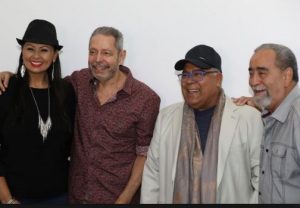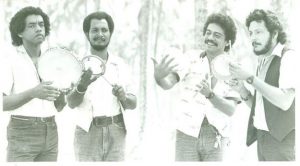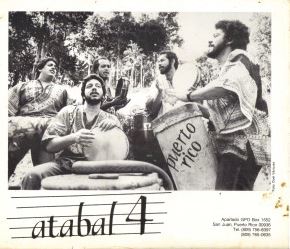This post is also available in:
 Español
Español
Hector “Atabal” Rodriguez is one of those people that followed his passion to not only make a living but more importantly, to make a difference.
He founded the group that bears his nickname, choosing the difficult path of focusing their music on folkloric rhythms. Although this might not have been the best commercial decision, it helped revive Puerto Rico’s folk rhythms of Bomba and Plena.
Hector Rodriguez followed this path out of his “love for the art”, as the saying goes. He was a very pleasant and humble man; soft-spoken and unpretentious but still proud of what he achieved. Our conversation was like sitting down to have a virtual coffee together.
Hector “Atabal”; a Passion for Music
Although he didn’t grow up in a family of musicians, Hector Rodriguez grew up in a family that loved music and listened to it constantly.
At their house, which was located in the Tras Talleres sector of Santurce, PR (he jokingly remarks that Andy Montañez wasn’t the only one that came out of that sector), his parents and siblings listened to all sorts of music. Their musical preferences varied from guitar quartets (like the Cuarteto Mayarí, and Cuarteto Marcano), to Puerto Rican folk music, to Cortijo, and all the way to Tito Puente and Machito.

The first musical instruments he practiced were the cowbell and the maracas.
As Hector told me, “when I was growing up, there were some guitar and cuatro players who would gather in an empty lot behind my house to play and sing. The first time I grabbed the cowbell or the maracas and kept the rhythm with them. Eventually, in these gatherings, they would insist to ‘give the cowbell to the boy’, (the boy was me) because I could keep a good rhythm. They were great with the string instruments, but not with keeping rhythm with percussion instruments.”
Years later, after taking up the bongo as his preferred instrument, Hector “Atabal” had his first professional opportunity show up to him on a silver plate. A friend of his played timbales for the maestro Claudio Ferrer. His friend quit Ferrer’s Conjunto to go play with a Salsa band and recommended Hector to take his place. When he approached Hector, the future founder of Atabal was very reluctant to accept.
“I told him I don’t play timbales, and he said that since I played bongos, it would be easy for me to pick up the timbales. I then said, ‘but I don’t have timbales’, and he insisted ‘you can take mine’. He didn’t even charge me a nickel for it. I couldn’t refuse.”
He stayed with Claudio Ferrer for a year. After that, he began playing for various singers like Danny Rivera, Sophy, Nydia Caro, and many others.
Atabal Origins
In early 1983, Hector Rodriguez and some friends decided to create a group on the side to play music that was fun to them. Irving Garcia and Jorge Arce (of Haciendo Punto en Otro Son), and Ramon Pedraza (a street “plenero“) joined Hector to form the un-named group.
“The idea came from watching the Cuban percussion and voice group ‘Los Papines’ play. They had a “music-and-show” thing where they would play and sing Guaguancó, and added a show with a bit of comedy, etc. I saw that and wondered why we couldn’t do the same but with our Puerto Rican rhythms,” Hector recalled.

Because they were a small group of four or five members, it was easy for them to travel. And travel made them better.
“When you travel, we have to be with each other and play all day. We got better because you have no choice but to get better”.
“For some time we didn’t have a name. Then one day Irvin Garcia came up with an idea. The leading name we were thinking of for the group was “Tambor” (Drum). One day Irvin said he learned that Atabal means drum in places in Central and South America. We liked the name as it was short and strong. We had to do a lot of explaining as to what the name was, and we still do it to this day, but we liked the name.”
By the end of 1983, Atabal made their first recording, “Del Caribe al Brasil” (From the Caribbean to Brazil). This gave them even more work. As Hector recalls, “we played Bomba and Plena, but also other rhythms of the Caribbean and Central & South America.”
Atabal Focuses on Bomba and Plena
“We all loved Bomba and Plena, so we focused on those rhythms. I had friends that suggested we needed three dancing girls in front to attract people. Others suggested we go into Merengue, as in the 80’s it was very popular. Thank God I didn’t listen to any of them”.
“People told us it was not a good commercial idea. But I liked what Los Papines were doing in Cuba, and we thought that Bomba and Plena are as danceable as Salsa. So we went forward with the concept of a voice and percussion group and added a show to it.”

Hector “Atabal” continued to explain that “at the time we organized, there were only about five or six bomba and/or plena groups. There was Quinto Olivo, the guys from Ponce ‘Los Guayacanes’, Pleneros de la 23 Abajo, there was Paracumbé, and a couple of others.”
Hector “Atabal” Rodriguez believes we need both, groups that play the traditional Bomba and/or Plena, like Los Cepeda, and also groups that will continue to evolve the genre to make it more contemporary.
“There are more Bomba and Plena events these days than ever before. Every weekend there are Bombazos or Plenazos in towns and cities around the island. I see more younger people involved with these rhythms, especially with Bomba, than I have seen in the past. So I’m happy and satisfied to see that the new generations are embracing this music. I’m at peace.”
Atabal Today
As a result of the hard work and position they have earned in the growing Bomba and Plena scene, Atabal keeps very active these days.
Hector’s son, Caymmi Rodriguez has taken over the group’s leadership. “Caymmi had to prove he was worthy of being in the group. He had to earn his place, not be here because he’s the director’s son.” With that, Caymmi learned and polished his Bomba and Plena skills with the groups of Ramon Pedraza and Modesto Cepeda. He spent several years with these groups before joining Atabal.

“Caymmi knows what singing a Bomba or a Plena is like. Besides that, he knows how to play, and even writes.” Hector “Atabal” says proudly.
Caymmi has now been with the group for about 8 years. He has helped the group evolve into a more contemporary sound. His songs are of romantic or festive themes. This follows perfectly the taste music fans are currently enjoying in other genres.
“We were already starting to go in that direction…”, Hector adds, “…but Caymmi has helped us in that regard.”
In 2011, the group recorded a great album titled “Soneros en la Plena” with a great list of guest singers. These included good friends Andy Montañez, Tito Rojas, Victor Manuelle, Luisito Carrion, Jerry Medina, Wichy Camacho, Juan Pablo Diaz, and Herman Olivera. It also included Reggaeton stars Vico C and Julio Voltio.
After releasing a few singles like “Hasta Que Amanezca” and “Me Diras Que Si”, the group will finally release a new album (EP) later this year. A new single from the album will be released shortly. It’s titled “Yo Soy Atabal”.
Another aspect that Caymmi has brought to Atabal is the use of videos to promote their songs.
“These days, more people watch videos than those that listen to the very album,” Hector says rightfully. “Caymmi is very meticulous with that, and the new video of “Yo Soy Atabal” is great.”
Legacy of Hector “Atabal” Rodriguez

What started as a group of four individuals with a passion for Puerto Rican rhythms, has now evolved into a 10 or 11-piece band. Atabal is run like an organization, with Caymmi now heading the group, and Hector’s widow, Maria Rivera Laborde as their Chief of Public Relations.
Atabal began in the early ’80s when people questioned the very survival of Bomba and Plena. It would take more than a decade later for one of the most popular groups in this genre, Plena Libre to be formed. In the meantime, Atabal was one of the few groups holding the walls together, nourishing Bomba and Plena so that they could survive and grow to the position they have today.
More still needs to be done for these Puerto Rican genres. However, we owe a lot to Hector “Atabal” Rodriguez for his contributions through Atabal.


Great article!
Thanks Hernam! Hope you enjoy the other articles in Latino Music Cafe, like the blog series on Bomba y Plena.
Saludos!